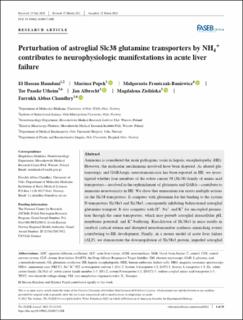| dc.contributor.author | Hamdani, El Hassan | |
| dc.contributor.author | Popek, Mariusz | |
| dc.contributor.author | Frontczak-Baniewicz, Małgorzata | |
| dc.contributor.author | Utheim, Tor Paaske | |
| dc.contributor.author | Albrecht, Jan | |
| dc.contributor.author | Zielińska, Magdalena | |
| dc.contributor.author | Chaudhry, Farrukh Abbas | |
| dc.date.accessioned | 2022-03-08T08:22:11Z | |
| dc.date.available | 2022-03-08T08:22:11Z | |
| dc.date.created | 2021-07-21T13:56:31Z | |
| dc.date.issued | 2021-06-24 | |
| dc.identifier.citation | The FASEB Journal. 2021, 35 (7), . | en_US |
| dc.identifier.issn | 0892-6638 | |
| dc.identifier.issn | 1530-6860 | |
| dc.identifier.uri | https://hdl.handle.net/11250/2983630 | |
| dc.description.abstract | Ammonia is considered the main pathogenic toxin in hepatic encephalopathy (HE). However, the molecular mechanisms involved have been disputed. As altered glutamatergic and GABAergic neurotransmission has been reported in HE, we investigated whether four members of the solute carrier 38 (Slc38) family of amino acid transporters—involved in the replenishment of glutamate and GABA—contribute to ammonia neurotoxicity in HE. We show that ammonium ion exerts multiple actions on the Slc38 transporters: It competes with glutamine for the binding to the system N transporters Slc38a3 and Slc38a5, consequently inhibiting bidirectional astroglial glutamine transport. It also competes with H+, Na+, and K+ for uncoupled permeation through the same transporters, which may perturb astroglial intracellular pH, membrane potential, and K+-buffering. Knockdown of Slc38a3 in mice results in cerebral cortical edema and disrupted neurotransmitter synthesis mimicking events contributing to HE development. Finally, in a mouse model of acute liver failure (ALF), we demonstrate the downregulation of Slc38a3 protein, impeded astroglial glutamine release, and cytotoxic edema. Altogether, we demonstrate contribution of Slc38 transporters to the ammonia-induced impairment of glutamine recycling between astrocytes and neurons, a phenomenon underlying acute ammonia neurotoxicity in the setting of ALF. | en_US |
| dc.description.sponsorship | This work was funded by the National Centre for Research (NCBiR) Polish-Norwegian Research Program (No Pol-Nor/196190/23/2013), South-Eastern Norway Regional Health Authority (ID: 21561/2017052) and Molecular Life Science. | en_US |
| dc.language.iso | eng | en_US |
| dc.publisher | Wiley Open Access | en_US |
| dc.relation.ispartofseries | Wiley Open Access;Volume 35, Issue 7 | |
| dc.rights | Attribution-NonCommercial-NoDerivatives 4.0 Internasjonal | * |
| dc.rights.uri | http://creativecommons.org/licenses/by-nc-nd/4.0/deed.no | * |
| dc.subject | Hepatic encephalopathy | en_US |
| dc.subject | NH4 + | en_US |
| dc.subject | Slc38 | en_US |
| dc.subject | Slc38a3 | en_US |
| dc.subject | SNAT3 | en_US |
| dc.title | Perturbation of astroglial Slc38 glutamine transporters by NH4 + contributes to neurophysiologic manifestations in acute liver failure | en_US |
| dc.type | Peer reviewed | en_US |
| dc.type | Journal article | en_US |
| dc.description.version | publishedVersion | en_US |
| dc.rights.holder | © 2021 The Authors | en_US |
| dc.source.articlenumber | e21588 | en_US |
| cristin.ispublished | true | |
| cristin.fulltext | original | |
| cristin.qualitycode | 2 | |
| dc.identifier.doi | https://doi.org/10.1096/fj.202001712RR | |
| dc.identifier.cristin | 1922346 | |
| dc.source.journal | Wiley Open Access | en_US |
| dc.source.volume | 35 | en_US |
| dc.source.issue | 7 | en_US |
| dc.source.pagenumber | 19 | en_US |
| dc.relation.project | National Centre for Research/Polish-Norwegian Research Program: No Pol-Nor/196190/23/2013 | en_US |
| dc.relation.project | Helse Sørøst: 21561/2017052 | en_US |

